Building a bug out bag has got to be one of the most widely discussed prepping topics there is, with everyone giving their opinion as to what should be included. Some people go for a more minimalistic approach, like that suggested on FEMA’s ready.gov website. Others have just about every piece of survival gear you can imagine, as if they were going to disappear into the woods and never return again.
A lot of this has to do with the type of bug out that one is planning. If you’re going down the road and are going to get a hotel, you don’t really need a lot of wilderness survival gear. On the other hand, if there’s a chance you’re going to spend even one night out in the wild, you’re going to have to be prepared. Any bug out bag must be prepared with not just the idea of what I absolutely will need, but also, what I might need if something goes wrong with my plan.
Related: 10 Awesome Food Ideas for Your Bug Out Bag
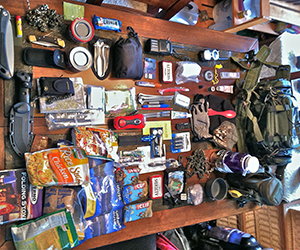
Food Weight
Here’s the problem though: everything you put in that bug out bag adds weight that you’ve got to carry.
Backpackers have known this for years and work to reduce their overall pack weight constantly. They’ll spend big bucks on a new tent or sleeping bag, just because it knocks a couple of ounces off their load.
One of the easiest ways for you and I to cut weight out of our bug out bags, is by limiting the amount of food that we are carrying. That may seem a bit contradictory, because I’m normally advocating the idea of upping the amount of food from three days to five. But it’s actually not a contradiction.
What I’m advocating for is using a bit more wisdom in the food choices that we make, so that we can keep the overall food weight down to six pounds.
6-Pound Mark
That six pounds number may seem a bit arbitrary, but it’s an important number of you want to keep your overall pack down to 25 pounds or less. With the ideal backpack weight being no more than 20% of your body weight, a 150 pound adult should be able to carry 30 pounds. But that’s assuming they are in good shape physically. If you’re not in good shape or you weigh more than 150 pounds, you probably can’t comfortably carry 20% of your body weight all day long while walking.
Six pounds means that you’re eating two pounds of food per day or 10 2/3 oz. of food per meal. That’s actually quite a bit and will provide you with a considerable amount of caloric intake. Walnuts, for example, are one of the highest calorie foods on our list at 185 calories per ounce, so 10 2/3 oz. of walnuts works out to 1974 calories, almost a full day’s caloric intake.
Okay, so how do you do that and still have enough food to last three days?
Less Water
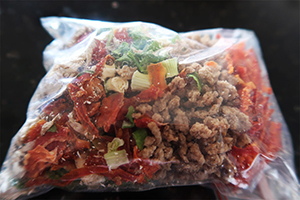
To start with, avoid any canned food or meats; this includes canned in plastic pouches. When you’re carrying food in plastic pouches, you’re carrying water.
Better to have something that’s either dehydrated or freeze dried and reconstitute it along the way.
In some cases, freeze dried foods are a better option than dehydrated. It all depends on the food and how dry “dehydrated” actually is. But one place where it’s definitely drier is in fruits. Dehydrated fruits contain considerably less water than dried fruits, making them lighter.
Avoid carrying extras too. Snacks can add a considerable amount of weight to your pack, especially since snack bars and granola are made of dense, fairly heavy food items. We’re talking survival here and going a few days without snacks of any sort isn’t the biggest survival problem you’ve got to deal with. You’re probably going to face days where you may not have enough food, let alone having your favorite snacks available to you.
Lots Of Calories
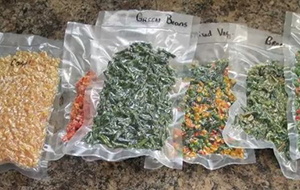 At the same time, you’ve got to pack a lot of calories into that food. So you want the foods which are going to give you the most calories, for the least amount of weight.
At the same time, you’ve got to pack a lot of calories into that food. So you want the foods which are going to give you the most calories, for the least amount of weight.
Put another way, you want foods that are high in calories per ounce, while not forgetting to include all three of the dietary macronutrients:
- Carbohydrates – converts to sugar to give your body energy
- Fats – converts to sugar slower than carbs, so you get a one-two punch of energy
- Proteins – provides the basic building blocks for cells, so that your body doesn’t have to cannibalize living cells to get that protein
For the short period of time that your bug out bag has to feed you, it’s okay to forget about the micronutrients. You don’t want to do that for too long, but you can for short periods of time, without your body suffering any harm.
Okay, so what particular foods can we include in those six pounds, so as to have the macronutrients we need, without having too much weight?
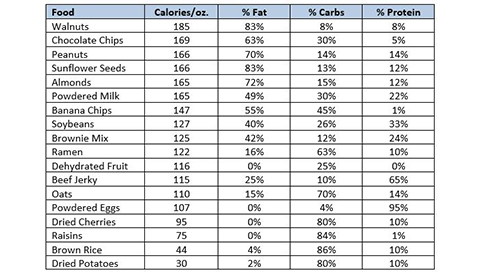
Of course, you’ve got to think beyond those three days and have a source of resupply ready, whether that is at your survival retreat or a supply cache. While you can survive for a number of days without food, going without will affect your energy level and concentration. Eating gives your body ready energy to use, even if it has to draw more energy from your fat reserves.
Related: The Best Foods You Need When Bugging Out
Refill Along The Way
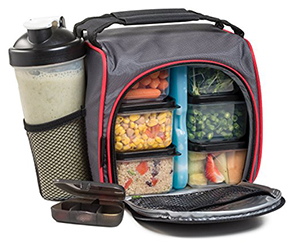 It’s a good idea to be ready to augment this food sack along the way, gathering fresh greens that you can eat and fishing if you have the opportunity.
It’s a good idea to be ready to augment this food sack along the way, gathering fresh greens that you can eat and fishing if you have the opportunity.
But you have to balance that against the amount of time it takes to do those activities.
If you spend four hours fishing or foraging, how much distance did you lose? Are you going to gain enough calories in the food you gather, to more than compensate for that time you’ve lost? If not, then it’s not worthwhile.
One useful way of making the most of your travel time, while still harvesting food from nature, is to set fish traps at night while you camp. In that way, you only spend a minimal amount of time on fishing, while still gaining the opportunity to supplement the food you are carrying.
Foraging for edible plants should only be done as you are on your way; not taking time out from traveling to do so. Learn how to recognize a number of likely plants for your area, so that you can pick them as you go and will have them ready when it is time to stop for lunch or for the night.
You may also like:
 My 3 Bug Out Bags (with Pictures)
My 3 Bug Out Bags (with Pictures)
If You See This Plant in Your Backyard, Burn It Immediately! (Video)
The SHTF Diet: Minimum Food And Water Supply For 3 Months
BOB from the Dollar Store for $50

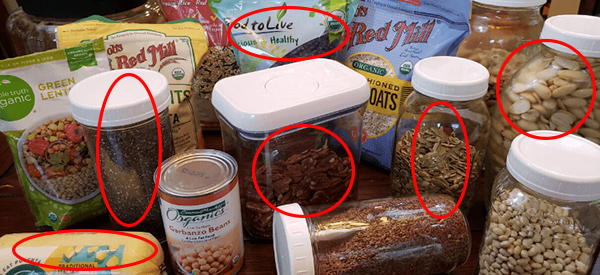













Rich M.
Great and well thought out article with a lot of practical information. The calorie chart you added is excellent.
Thank you.
The only thing I would add is to make sure you rotate the food. Especially the Walnuts, Peanuts, Sunflower seats, and Almonds. The all contain oils that will spoil quickly especially if your BOB is not kept in a cool location.
So… Nuts, dehydrated fruit, and high calorie, nutrition dense foods that are either dried or dehydrated… Sounds like we’re back to pemmican and gorp.
Nice list, but how about an example?
Still need water no matter what.
Yes ! Water is #1 need….for drinking, cooking, washing and disposing of waste
Living in a blue city, like I do….
this will show who continues to live on earth & how long?
epic, though not common knowledge, thats epic!
Apparently Rich based his article on getting to your destination in three days by shank’s mare and that you will be able to find water along the way while hauling your load on your back.
That works as long as your destination is about 30 miles away. Further away, better count on carrying a few more pounds of rice and beans, Pilgrim.
On the other hand, as I have previously reiterated on so many occasions, I feel like the record has some grunge on it and it keeps skipping back to the same refrain.
Plan on hauling your load rather than carrying it on your back. You can haul a 60 pound load on a two wheel luggage cart a heck of a lot better than you can carry a 60 pound load on your back. The Vietnam Peoples’ Liberation Army hauled an average of 440 pounds on their bicycles over 1200 miles. Try staggering 100 yards with 440 pounds on your back.
In addition, you can get into action quicker by just dropping the handle of the luggage cart and running to cover than you can perform the same action loaded down with your 60 pound pack with the two shoulder straps and the sternum strap and the waist belt together with your rifle and whatever else you have hung on your pack.
Don’t believe me? Try it.
Don’t have a luggage cart handy? Make a travois. Using paracord — you do have paracord with you in your bug out bag, don’t you — and your pack, you can make a travois. The Indians used travois to haul their teepees and the rest of the village paraphernalia when they moved their villages before they invented horses. The kids and even the dogs hauled travois. They weren’t traveling on Route 66 either. They were going over unbroken prairie with their travois, so wherever you are going, a travois is probably going to be able to follow along.
You can find suitable branches to make some sort of travois in almost any urban setting. Hack a couple of branches off a big bush or a small tree. It doesn’t have to win any awards for “Best Built Travois,” all it has to do is haul your gear. If you find better poles, ditch what you have made. It’s not like you have invested your total 401(k) in its manufacture.
Stop thinking, “I’ve got to be macho man and haul all of this stuff on my back.” It’s dumb. Take a tip from the Indians who were the original “live off the landers”
Even across the desert or deep snow, a travois is going to make easier going than staggering along with a pack on your back.
The article was about what food to carry in your bag. I do not believe it eliminates having water, specifically. No one is going to advise you to bug out without water.
Again, the article was about food.
He also stated, you must think beyond three days and have resupply ready.
What if your luggage cart busts a wheel or rips/cracks or the handle breaks? What if you have to go off road?
Those carts are not meant for off road type of use. They’re also awkward and cumbersome for some people.
The same can be said for a bicycle.
You hit one situation where you can’t continue with it and you are stuck taking only the gear you can carry on foot.
Again, having 400 pounds of gear makes you more of a target, as well.
How are you going to drop your stuff and seek cover on a bike or provide yourself firearm cover?
I would prefer to have both hands free. which counteracts the inability to just let go and run.
Stop being a macho man and thinking you have to haul enough to set up an entire village and keep it supplied for 6 weeks.
The point of this article and so many that you argue with is getting from point A to point B, preferably in three days or less, with a resupply option if it needs to take longer.
You must also take into account it’s a generalized approach, amenable to unique situations. You must balance ease of transport with what makes you a target.
I don’t want my gear/food sitting out in the open on a travois, for the world to see what I have.
I don’t ant the extra attention using that will bring.
You are also short changing the distance I can travel on foot.
2 MPH per day, 12 hours per day is 24 miles per day or 72 in three….not 30.
You only move at the speed of the slowest in your group. I’m a very fit 74 and can out perform/last many younger guys but it your partner or child will be with you and is infirm or less fit, etc., then you’ll never see 2 mph let alone a 12 hour day. Nothing wrong with a Travois, or a cart. Start with a cart if it’s ready and handy. When it dies or you have to go cross country put the bag? off it on a Travois and drag it. Lots of hunters use a single wheel Travois to bring game back from the field and it works fine. You refer to the 440# the NVA could carry on a bicycle but ignore their conditioning and the trails which were mostly beaten paths in the jungles. Trust me when I say the 440# wasn’t a tent or soft goods. 4 or more spam cans of ammo, a crate of grenades and a 20# sack of rice or two was more the norm. They certainly did not ride those bikes as they Trundled them thru the jungle on their journey. Ahead of time make up a shoulder harness from an old Alice pack or something similar. Use the belt on your hips for the load and the shoulder straps to add stability not much weight. That will leave your hand free for your rifle or shotgun etc, and your backpack for must have items and the proverbial 6# of food.
For larger loads I have a two wheel travis with fat tires that has handle bars at each end, A welded affair it uses motorcross handle bars welded to the skeleton steel frame. I use it for Elk hunting normally. One guy pulls wearing a harness and two or four walk alongside and grip a handle bar end. If the ground is and old logging road or semi desert two of the guys can walk along behind and spell the other two or the puller as required. We’ve used it many, many time to take game out of areas you would not believe and the load usually runs about 300#. I used fat knobby tires when I built it and welded them just far enough apart to clear the center scruff you see in the outback on old roads. I think the biggest Elk we brought out on it went about 550# with the head and horns and most of that was over 6-10 inches of snow on top of dirt and sage brush. So rethink the cart or Travois in your plans. It doen’t have to just be 2 sapling poles dragging a teepee in the dirt. Best Bob in WA State,
Agency Man: I think you should write a more detailed article with pictures for Claude about your heavier game cart and its construction. It sounds like a great bug out vehicle to me. Great reasoning. Any device that allows you to cover more ground is a plus even if you have to abandon it part way there. A bicycle that tacos a wheel 3/4 of the way to your destination still have shortened your travel time considerably. If you are able to carry a load while pushing a bike faster than you can carry that load on your back, and you eventually have to abandon that bike you are still that much further ahead.
FLYOVER: There are so many downsides to caches that I won’t even bother to list them. It is fine if you live in a rural area and there is plenty of public land on your route to cache supplies. I think most of the followers of this list live in urban or semi-urban areas and the public land is where they are headed for their bug out location. Perhaps you can get away with burying a cache in the flower bed of a high school but I wouldn’t count on it remaining undiscovered long term.
Rather than counting on hiking every day at maximum hours, I would think a safer course would be counting on 2 mph at 5 or 6 hours a day. There are calls of nature that must be answered which will cost you time. You will want to select a secluded spot where you aren’t exposed. Not so much for modesty as for safety. Unless you plan on hiking after dark your 12 hours is a summertime exercise. If you need to bug out in December, it goes out the window.
Are you going to eat all your meals while moving? Are you ever going to take a break in your line of march? Are you going to carry enough water so that you don’t have to stop to purify a couple of containers of water to continue on? Is everything going to be eaten cold? A hot meal goes a long way toward feeling energized even if the calories are the same. That’s why the current MREs contain a heater than can be used while on the march. But MREs are heavy.
What about detours? If you run into roadblocks, you will have to detour. You don’t know how far that is going to take you out of your way. You may have to hide on your route to allow possible hostiles to proceed past you a safe distance before you go on.
Along your route, even if you do plan to hike some after dark and I would suggest that you would be better off either hiking solely after dark and finding a hide before daylight or stopping early enough to find a sufficient hide for overnighting. You don’t want to be tromping around after dark trying to find some place to overnight.
What about blisters? If you or your party develop blisters because you just aren’t accustomed to hiking 12 hours carrying a pack is that going to slow down your march rate? Your chances of developing blisters carrying a pack when you are unaccustomed to doing so is pretty good.
Having done some multi-day hiking and having done a lot of multi-day bicycling, I think 25 miles a day on a loaded bicycle is doable by most folks who have more experience riding a bike than just two or three times a year. If they fall into the 2 or 3 times a year for a mile or 2 category I think 15 miles a day is more likely. Unless you are an experienced hiker, accustomed to long hikes with a weight on your back, I think 10 miles a day is the maximum anyone bugging out should plan on. I think it is better to plan on the minimum and be pleasantly surprised when you manage to get more than it is to plan on the maximum and be disappointed frequently when you aren’t able to achieve it.
So right, it all comes down to logistics! It would be extremely foolish of me to think that I can hide caches of supplies out here in the big city. There are far too many variables. First, you never know just where you might be when you find you actually need to bug out! You have to be at the ready at all times. You have to be confident and flexible! Here you have to have wide network in place in all directions. That’s your cache! You have to quickly make decisions, have a general plan in place and you can not do anything that would impede on forward mobility.
CC: Good thinking. You could be in Manhattan and your bug out plans are to go through Long Island or Staten Island. Oops!
What is it Bobby Burns said about mice and men and plans?
Flyover Country Rick, What the liberal media folks call flyover country, I like to call the Heartland of America! ??
It’s where folks have commonsense and know how to use it! Appreciate you comments here. Makes sense to me!
If worse comes to worse, pile your goods in trash bags, put them in a shopping cart and dress in layers. If you appear to be a homeless person you might be a less attractive target…most people tend to ignore the homeless for fear they’re going to ask for money or talk crazy. Cynical but true.
well you try climbing the hills of wv pulling a luggage cart i’ll stick with my pack now if i ever move to ohio where it’s mostly flat then a cart my be an option but you’ll never pull a cart here very far to thick and way to steep
As my Grandmother used to say, “You can lead a horse to water but you can’t make him drink.”
One can but offer suggestions. Whether they are adopted or rejected is up to the individual.
I really like that bag you used as a display, with the plastic containers, where does one find that?
Article is great idea for an interesting and useful exercise. At the Wal Mart online shopping site you can search an item you might like to pack and the nutrition info comes up on the same page. I made a list of my own, the one in the article is mostly stuff I’d give away to the less fortunate. I always carried a few cans of chili, beans, and spaghetti on long hikes, you pay a weight penalty for the cans but get the bonus of comfort food after a long hard day. List is product, size, total calories.
Sardines in oil, 3.7oz 150c. Spam, 7oz 630c. Deviled Ham, 4.25 oz 360c. Pork and Beans, 16oz 820c. Chips Ahoy Chocolate Chip Cookies, 4oz 640c. Potato Chips, 8oz 1200c. Beef Jerky, 10oz 700c. Spaghetti and
Meatballs 7.5 oz 200c. Vienna Sausage, 4.6oz 240c. Fried Pork Skins, 5oz 800c. Tequila, 1.5 oz 100c. Hershey bar, 1.55oz 200c. Marshmallows, 10oz 900c.
Graham Crackers, 7 oz, 750c.
OK! IvyMike! Now you’re making me hungry! To your list I would like to add a couple of individual packets of dried coffee, tea bags, dried soup mix and a few saltines! Haven’t weighed it, but I don’t think it would add all that much weight to the total sum, but it would add some variety and a ton of flavor!
Saltine crackers, 8oz 980 calories. The saltine cracker is the most under rated survival food of all. My Grandmother made mock apple pie out of saltines. Bob Wills wrote a great Depression era song called Big Ball In Cow Town, the refrain is “workin’ on the railroad/sleepin’ on the ground/ eatin’ saltine crackers/10 cents a pound.” And there is always the immortal image of Lee and Jackson planning the last day of the battle of Chancellorsville around a fire late at night sitting on cracker boxes. White crackers, saltines, were a vital source of calories for both sides.
Individual packets of dried coffee? I ain’t bugging out unless I’m assured my Starbucks Card is still working.
………
It might not have any calories, but there is nothing like a hot cup of coffee on the 0000 to 0400 watch. Nor is there anything that matches a hot cup of coffee after being outside in inclement weather for an extended period although a hot cup of bullion in that circumstance is a close second, especially if it has saltine crackers broken up in it.
LCC – All of my plans include making sure I can get a cup of coffee wherever I may be! To me, it’s a good place to start! Once that’s taken care of, I work on the rest! In cold climates during the winter, a couple of packages of hot cocoa works well too! But nothing replaces that cup of coffee!
well you try climbing the hills of wv pulling a luggage cart i’ll stick with my pack now if i ever move to ohio where it’s mostly flat then a cart my be an option but you’ll never pull a cart here very far to thick and way to steep
LCC – Yes! And I could have my office on the 26th floor and be in a meeting on the 5th floor when the SHF and I’m not going to be able to go back up! Been there. Done that. Better than be trapped in the subway though. Been there too!
CC: I hadn’t thought of that, but yes, that is a definite possibility. If you don’t have your walking shoes with you, schlepping down five flights of stairs is going to be a challenge in itself.
Might I suggest that you always carry a pair of those leather soled socks you see advertised in your briefcase or purse? The leather soles will add a bit more protection than walking down concrete stairs in your stocking feet. Make sure you get good quality because there are some really cheap ones in the market that have leather soles about as thick as a sheet of paper.
If not the leather soled socks, then at least a pair of soft moccasins that can fold a bit in your briefcase or purse.
36000 folks are going to be without electricity this afternoon and evening in Los Angeles. Fortunately, we don’t have many really tall office buildings. Still, walking down 20 flights of stairs in high heels or stocking feet because you hung around the office a little too long is going to make for an unhappy camper.
Matt – For security purposes, post 911 rental lockers are for the most part non existent here in the big city unless they’re in a health club and you are a member physically working out on premise! Heck it’s difficult to find a post office box or even a safe deposit box these days! If you’re stopped with that folding knife, you’ll not have to worry about bugging out, you’ll be bugging in for a long long time!
CC: That was my thought about lockers. I wasn’t sure if Matt was talking about storage lockers such as we see in low rent areas where you can rent an 8 x 10 locker or larger to store stuff. I have mixed feelings about them. Usually they are located in a less desirable area because the property costs are lower. That is problematical in my opinion because the natives in that locale may loot the storage lockers first because no one is there and it is like a treasure hunt.
Prepper novels are loaded with preppers who have pre-positioned vast supplies in storage lockers and fortunately they have never been looted before the pepper hero of the novel shows up, although the bad guys usually show up just as the preppier and his group are getting ready to leave the scene and they have to battle off the bad guys but are able to do so because of the vast amounts of ammunition and unique weapons they have stored there.
Or, if Matt was talking about the luggage storage lockers one used to see in bus stations, train stations and airports for the temporary storage of luggage while in the loo or the bar or both. I haven’t looked for them but I think, as you stated, 9/11 signified the death knell for those conveniences.
The other concern I have about the rent-a-locker facilities is that sometimes the entrance is electronic and you need to punch in a code to get in the gate. In an electronic EOTW, the electronic gate is not going to work and you are going to be forced to either cut out a section of chainlink big enough for your vehicle which may give bad guys lurking in the neighborhood the idea that someone has driven a vehicle in there and they ought to go check it out. OR, you cut a hole just big enough for the members of your crew to ingress and egress and you physically move your stored goods from the locker to your vehicle or bug out travois or whatever.
The possibility of an electrical EOTW in my opinion ranks right up there with a 9.0 earthquake on the San Andreas Fault. That’s why I won’t buy any storage device with an electronics only locking device. It has to have a manual override or I don’t even consider it.
In NYC, of course, that low crime utopia of the U.S., law-abiding citizens are forbidden to carry anything that remotely resembles a weapon. In less urbane locales, citizens can sometimes carry a surprising variety of self-defense devices. To wit: Sword canes, blackjacks, brass knuckles, knives, even switchblade knives, walking sticks that are in actuality clubs. Even in the PDRK, that haven of hoplophobes, the law abiding citizen can actually carry up to a 4-inch bladed knife concealed. One can legally carry a sword as long as it isn’t concealed, although if one does that, one is liable to spend a considerable amount of time each day having a dialog with various law enforcement officers. I will say though we have a bum in town who regularly carries a 12 inch bowie knife strapped to his leg. He always wears shorts, no matter what the weather and so his knife is not concealed and while I am sure he has been hassled by the cops about it frequently, he still goes about his daily business with it strapped to his right leg down below his knee.
Do you carry your steel-toed shoes with you daily? I can’t see showing up for an executive policy meeting wearing steel-toed Doc Martens, but then it’s been a while since I was so involved. They seem a little awkward to schlep around on a daily basis. Do you carry them in a gym bag? Your post raised all kinds of interesting mental pictures.
LCC – Here in the big city, the less you carry the better off you are. That said, things have really changed around here Post 9/11. So has fashion. Boots are in so if you’re going to buy a pair, why not wear a pair of good ones? People are into self preservation almost as much as self promotion! Crime here has been taken up a notch quite a bit recently! We have always had it all here, but now our rioters are UES college graduates, with summer homes in Ct. and parents who are all highly paid professionals – Child psychiatrists who teach at Columbia University no less! Can’t make this stuff up LCC!
I would recommend that you get (if you don’t already have a pair) a pair of good quality steel toe work boots. They come in a lot of colors now, and will protect you from broken glass, loose nails, concrete chunks and can be useful if you have to fight your way out of a bad situation.
I bought a box of Sharpie Penske online. They don’t look all GI Joe like a lot of the Tac pens, but are silver, sleek with a very sturdy steel point. Good to carry where knives are not allowed. You still don’t want to get into a confrontation, especially a close-in one where it might be useful and running away from trouble is more prudent, but they are nice for what they are.
Sharpie pens.
The pen is mightier than the sword….also much easier to put in purse or pocket.?
LCC- All sounds so so comfy and cozy, but I’ll have to save it all for a winters night at home by the fire, just as I have to leave the 5” high heeled shoes under the desk, and stick to foot ware with steel toes and shanks! Fashion cheek has a whole new meaning theses days!
If you can, rock the pantsuits ala Hillary. You can wear comfortable boots with them, and they are more practical than Chanel pencil skirts if you have to do a lot of walking. Keep a t-shirt in your briefcase or purse too, so you can blend in better. Most men wouldn’t notice your dress slacks with a casual shirt, but would likely notice the suit jacket. Keep a plastic or paper grocery sack to stuff it in if it won’t fit in your bag, and perhaps a fabric shopping tote with shoulder straps big enough to stuff your bag in if you normally carry a nice purse/briefcase at work.
Remember to go grey in a crisis.
It never pays to advertise! ????
Boots work quite well with a tea length dress and coat
?
fair points all. so let add a bit. Casheing in cities is not that challenging; prep several small cashes & put them in rent lockers round town, keep and label the keys. & yes add walking shoes; I keep a change of clothing in my kit.
it,s true we all need water so invest in a few personal filters they’re only 15-20$ each , keep 1 on you put the rest in your caches; I keep these heavier gauge 20 Oz drink pouches with caps (like freezable ICEE pouches). Drink the contents, wash them out presto collapsible canteen. lets not overlook things like pouches of jerky, nuts or wax encapsulated cheese these things keep a long time are easily stored & rotated.
I’m just saying.An emergency kit need’t be a 30-40 lbs pack; Rain poncho, mylar blanket, flashlight, fire starter, personal water filters & collapsible canteen, folding tactical knife, 50′ para-cord 4 pouches of jerky, 4 pouches of,nuts & 4 baby-bell cheeses all fits in a fanny pack! & can be buried in a coffee can, pick a spot.
Finally on travois a correctly assembled travoi can also distort (not obliterate) or foul your tracks & provide foliage cover in an emergency.
Matt: Very good point. That had not occurred to me. A couple of leafy branches tied to the travois ends to drag on the ground as one proceeds would indeed help cover one’s tracks in dusty or muddy areas. Very good point.
That’s what makes this site so valuable. So many contributors who make very valuable contributions by their comments and get the rest of us thinking.
Thanks everyone who has commented here. You have sparked many ideas for me, lots of things to consider plus the need for my weather and climate where I live. Bugging out in winter is a very tough one.
A lifestraw would also be a good addition. They’re small, and you know you will need water.
I learn a great deal from the articles posted, and even more from the comments/discussions afterward. I’m fairly new to prepping. Okay, new. And appreciate everything. Age 65 and know some of this, learning others.
If you are going to include powdered or freeze-dried eggs in your kit, consider Including a small package of real bacon bits, too, because everything goes better with bacon, it provides protein and fats and salt, and if you have a way to fry the eggs, putting the bacon bits in the pan first provides the grease you need to prevent the eggs from sticking to the pan. They don’t need to be refrigerated until you open the bag and, if you are figuring on a 3-day bug out scenario, they should be fine for that time span. And bacon really is the ultimate comfort food, isn’t it?
Also, include a few restaurant packs of sugar, some salt and pepper packs from any fast food restaurant Or, better yet, a few of the sealed packages of plastic utensils, salt, pepper, sugar, creamer and a napkin. I actually keep a pair of Ka-bar tactical chopsticks in my get home bag (a gift from my DH) along with a spork that pulls apart to reveal a knife and various zip-closure snack bags with tea bags (not a coffee drinker), sugar, Star Brite peppermints (they help to keep your mouth from getting dry without making you hungry like chewing gum does), water flavor enhancers and Emergen-C drink mixes. That doesn’t add up to very much weight but provides sugar, caffeine and some immunity booster. And these days, you can get the individual packages of water flavorings with Vitamin C, anti-oxidants, caffeine, electrolytes and without aspertame.
Great ideas, all! Thank you!! I do drink coffee, but like it with half and half or milk, the real dairy cow stuff. That’s hard to pack for three or more days. But I drink tea black, both hot and cold. DH likes the artificial stuff with his coffee, even powdered, so he’s easy. Tea bags are easy, and I ordered solar warmer heaters. LOVE those! Now all I have to do is get back in shape from cancer surgery and heart problems… easy, right?!? On my way! Day by day!
Hoosier Hill Farm sells dehydrated real heavy cream, whole milk, eggs and more. They sell on Amazon and direct from their farm.
Oops, solar WATER heaters! Not warmer heaters! I will eventually learn to proofread my writings. Thank you for putting up with my ramblings.